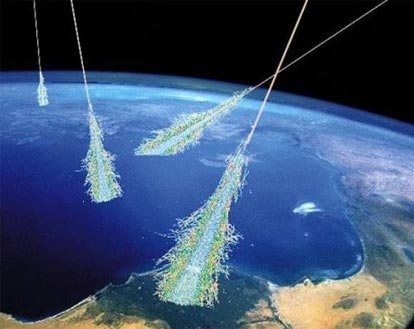“In recent years, research has suggested congenital birth defects down on Earth’s surface could be caused by these ‘solar particle events’ – spikes in cosmic rays from the sun that touch off the northern lights and sometimes hamper communications or the electric power grid,” according to Science Daily.
Even though airplane crews at high altitudes are exposed to harmful levels of radiation from cosmic rays, a new NASA-funded investigation has found that radiation emitted from solar events is too weak to cause defects to the Earth at ground level. The results of this investigation have been published in the Journal of Geophysical Research.
“We looked at two different studies. Both of them indicated a connection between cosmic rays and the rate of birth defects. One also associated mutations in cells growing in a petri dish with a 1989 solar particle event,” Adrian Melott, professor of physics at the University of Kansas and project co-author, said.
Merlott and his colleagues later determined the dose of radiation from a solar particle event is not enough to be concerned about.
“We have a contradiction. Our estimates suggest that the radiation on the ground from these solar events is very small. And yet the experimental evidence suggests that something is going on that causes birth defects. We don’t understand this, which is good. Something one doesn’t understand is a pointer to an interesting scientific problem,” Melott added.
The researchers then studied how cosmic rays from the sun create dangerous ‘secondaries’ when reacting with the Earth’s atmosphere.
“Cosmic rays are mostly protons. Basically, they are the nuclei of atoms — with all the electrons stripped off. Some come from the sun. Others come from all kinds of violent events all over the universe. Most of the ones that hit the Earth’s atmosphere don’t reach the ground, but they set off ‘air showers’ in which other particles are created, and some of them reach the ground,” Merlott said.
According to the team’s research, “air showers pose the most serious threat for the health of humans and other biology on the Earth’s surface via ionizing radiation.”
“Ionizing radiation is any radiation that can tear apart an atom or a molecule. It can affect life in many ways, causing skin cancer, birth defects and other things. Normally, about one-sixth of the penetrating radiation we get down near sea level is from secondaries from cosmic rays,” according to researchers.
The team also studied to forms of radiation formed by solar particle events – muons and neutrons. Their investigation determined muons are the most generous to Earth.
“Muons are a kind of heavy cousin of the electron. They’re produced in great abundance by cosmic rays and are responsible for most of the radiation we get on the ground from cosmic rays. Neutrons can do a lot of damage. However, very few of them ever reach the ground. We checked this because some of them do reach the ground. We found that they’re likely responsible for a lot less damage than muons, even during a solar particle event,” Melott said.
The team said the next step in their investigation will be gaining an understanding of how much exposure to muons that DNA can withstand.
“In calculating the effect of muons, we used standard assumptions about what the effect of muons should be. Their physics is pretty simple, just that of an electron with a lot of mass. But no one has ever actually done much experimentation to measure the effect of muons on DNA, because under normal conditions they are not a dominant player. They are not important, for example, in nuclear reactor accidents. We would like to put some synthetic DNA in a muon beam and actually measure the effect.” Melott concluded.
